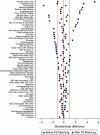Intensive Care Unit versus High-dependency Care Unit for COVID-19 Patients with Invasive Mechanical Ventilation
- PMID: 35984418
- PMCID: PMC9819267
- DOI: 10.1513/AnnalsATS.202206-475OC
Intensive Care Unit versus High-dependency Care Unit for COVID-19 Patients with Invasive Mechanical Ventilation
Abstract
Rationale: High-dependency care units (HDUs), also termed "intermediate care units", "step-down units", or "respiratory HDUs", are areas in which degrees of patient care and costs are between those of the intensive care unit (ICU) and the general ward. In general, patients requiring mechanical ventilation are treated in the ICU rather than in the HDU, except for the use of HDU beds as surge capacity beds during a massive strain; however, the HDU, as well as ICU, are used as the standard care units for mechanically ventilated patients with coronavirus disease (COVID-19) in Japan. Objectives: To assess the outcomes of patients with COVID-19 with invasive mechanical ventilation treated in the HDU versus those treated in the ICU. Methods: In this retrospective cohort study, we used a multicenter inpatient database in Japan to identify mechanically ventilated patients with COVID-19 in the ICU or HDU on the start day of invasive mechanical ventilation from February 10, 2020, to November 30, 2021. The primary outcome was in-hospital mortality within 30 days from the start of the first invasive mechanical ventilation. Propensity score matching was performed to compare the outcomes of patients treated in the ICU with those treated in the HDU. Results: Of 1,985 eligible patients with COVID-19 with invasive mechanical ventilation, 1,303 (66%) were treated in the ICU, and 682 (34%) were treated in the HDU on the start day of invasive mechanical ventilation. After propensity score matching, patients treated in the ICU had significantly lower in-hospital mortality within 30 days than those treated in the HDU (18.3% vs. 24.2%; risk difference, -5.8%; 95% confidence interval, -10.9% to -0.8%). Conclusions: This multicenter observational study in Japan suggests that care for mechanically ventilated patients with COVID-19 in the ICU may significantly reduce in-hospital mortality within 30 days compared with care in the HDU. Establishing a critical care system that would allow patients with COVID-19 requiring ventilators to be treated in the ICU is desirable. Because this study was an observational study, our finding represents an association, not causation. Further studies of different critical care systems are warranted to confirm our findings.
Keywords: coronavirus disease 2019; high-dependency care unit; intensive care unit; mechanical ventilation; propensity score.
Figures



References
-
- Truog RD, Mitchell C, Daley GQ. The toughest triage - allocating ventilators in a pandemic. N Engl J Med . 2020;382:1973–1975. - PubMed
-
- Dichter JR, Devereaux AV, Sprung CL, Mukherjee V, Persoff J, Baum KD, et al. Task Force for Mass Critical Care Writing Group Mass critical care surge response during COVID-19: implementation of contingency strategies - a preliminary report of findings from the task force for mass critical care. Chest . 2022;161:429–447. - PMC - PubMed
-
- Masa JF, Patout M, Scala R, Winck JC. Reorganizing the respiratory high dependency unit for pandemics. Expert Rev Respir Med . 2021;15:1505–1515. - PubMed
Publication types
MeSH terms
LinkOut - more resources
Full Text Sources
Medical

